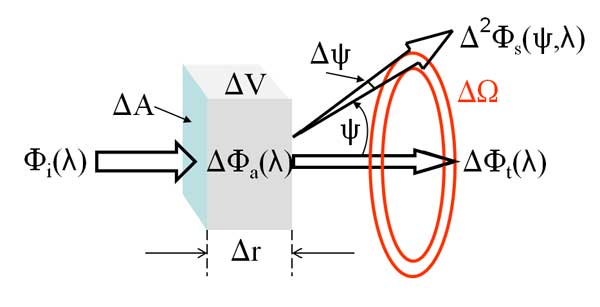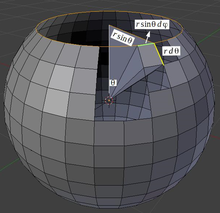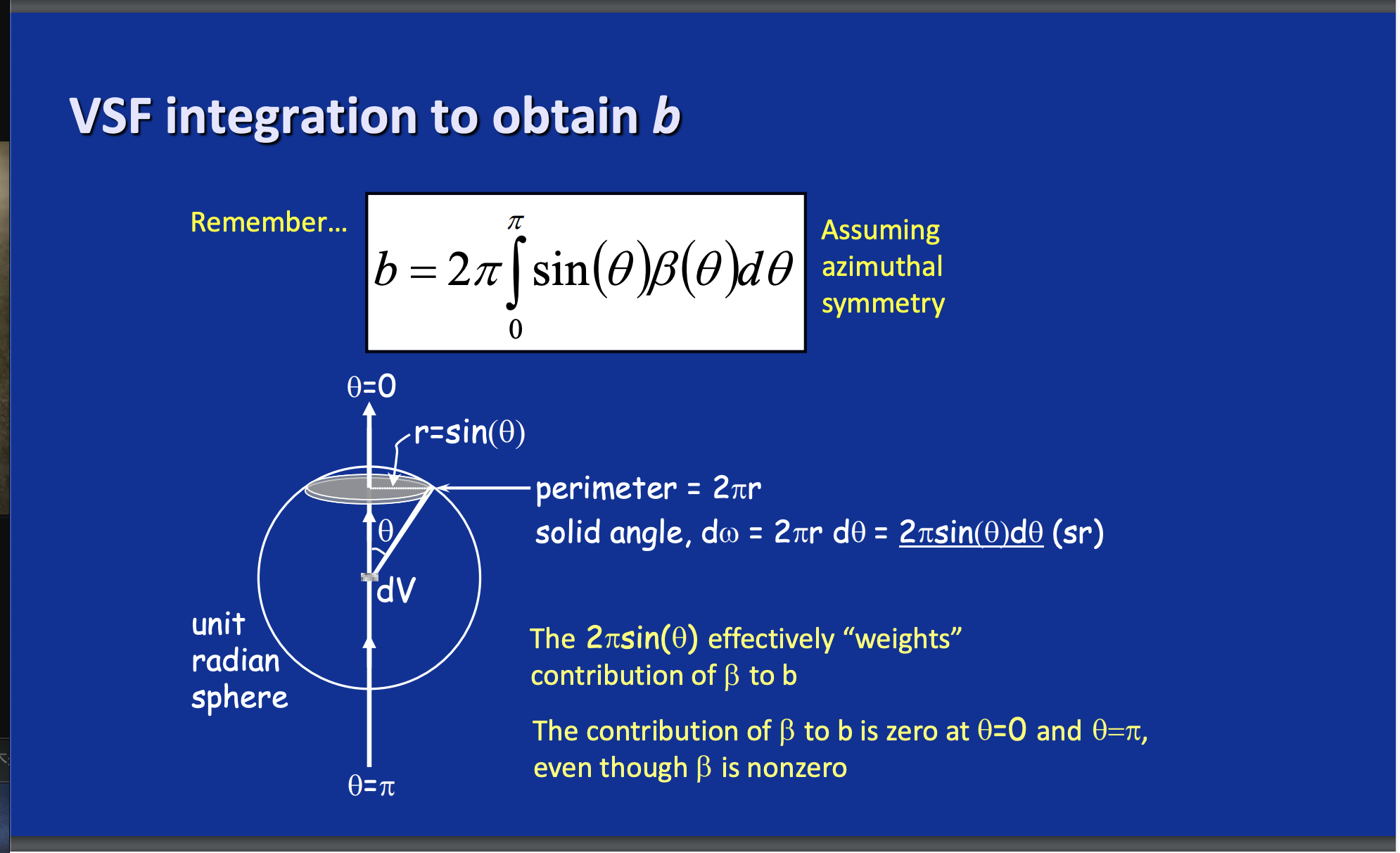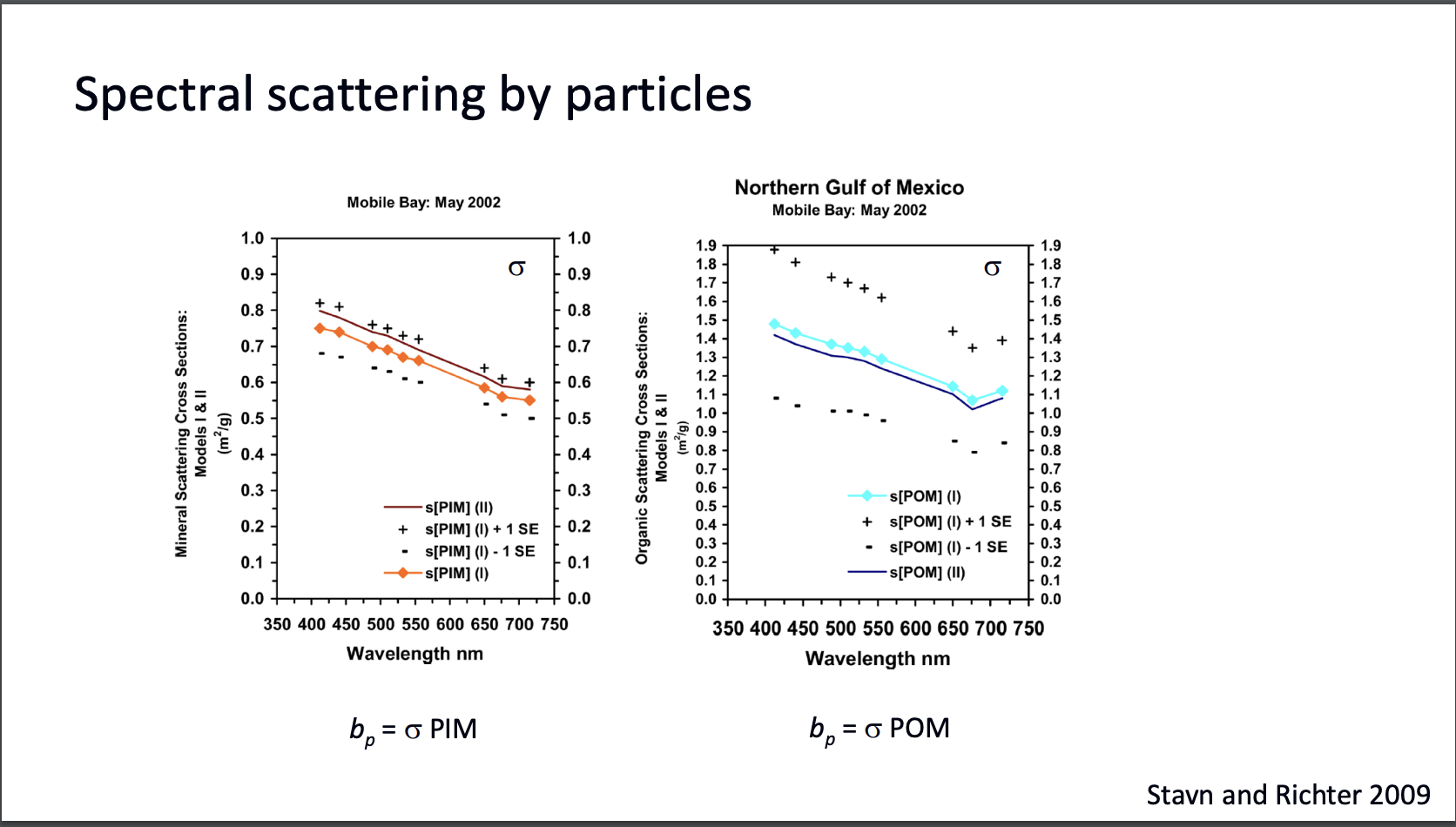The optics of backscattering
I need to understand the optics of backscattering to understand the strange ‘bbp’ calculted from Rrs and and.
Material mainly from IOCCG summer lecture 2018 and ocean optics web book.
Volume scattering function

the fraction of incident power scattered out of the beam through an angle ψ into a solid angle ΔΩ (total radiance inside the cone)centered on ψ, is Δ2Φs(ψ,λ)/Φi.
If we change Ω to Ω + ΔΩ, the increase part is inside the red ring,
The volume scattering function β(ψ,λ) is defined as the limit of this fraction as Δr→0 and ΔΩ→0:

The physical meaning of VSF is
scattered intensity per unit incident irradiance per unit volume of water
Or
the differential scattering cross section per unit volume.
So the scattering is the integration of VSF over all direction b(λ) = ∫β(ψ,λ)dΩ Ω is the solid angle
https://www.youtube.com/watch?v=VmnkkWLwVsc
https://www.youtube.com/watch?v=gLfYTP4F23g
https://www.youtube.com/watch?v=RMJucQJ1NGo
 $$
d\Omega=\frac{dA}{r^2}\\=\frac{d(rsin\theta
d\psi)(rd\theta)}{r^2}\\=\frac{dr^2sin\theta d\theta
d\psi}{r^2}\\=sin\theta d\theta d\psi
$$ By assuming azimuthal symmetry, this means it is a cone, the
eq2 can be simplifed as : $$
d\Omega=\frac{dA}{r^2}\\
=\frac{d(2\pi r^2(1-cos\theta))}{r^2}\\
=2\pi sin \theta d\theta
$$
$$
d\Omega=\frac{dA}{r^2}\\=\frac{d(rsin\theta
d\psi)(rd\theta)}{r^2}\\=\frac{dr^2sin\theta d\theta
d\psi}{r^2}\\=sin\theta d\theta d\psi
$$ By assuming azimuthal symmetry, this means it is a cone, the
eq2 can be simplifed as : $$
d\Omega=\frac{dA}{r^2}\\
=\frac{d(2\pi r^2(1-cos\theta))}{r^2}\\
=2\pi sin \theta d\theta
$$
$$
\therefore\\
b(\lambda)=\int\beta(\psi,\lambda)d\Omega\\
=2\pi\int_0^{\pi} sin(\theta)\beta(\theta,\lambda)d\theta\\
$$ 
The scattering is addictive

There are some other scattering properties

50% typically <3 to 4 deg

Scattering components
Pure water
The best value of pure water scattering is

detailed can check Lee lecture bases
Phytoplankton

Particles


DDA is most popular one but only could compute very small size
Improve IGOM for larger size
Rayleigh cover very very small
Mie all size but homogeneous spheres
T-matrix is also popular
Measurement
I’m not very totally understand this process
But one thing I can now is that
The backscattering is the integration, but the measurement is a weighted sum
Interpretation and Application


Mie theory
Beam Attenuation
Unlike backscattering or total scattering, particle beam attenuation is almost a perfect powe law shape $$ c_p=a_p+b_p\\ =a_{ph}+a_{nap}+b_p $$
Not here this is bp, total scattering , not backscattering. Backscattering only contributed to almost one to two percent of total scattering.
In order to related to the backscattering that can be received by satellite, we need one bridge b̂bp, defined as $$ \hat{b}_{bp}=\frac{b_{bp}}{b_{p}} $$ The b̂bp almost same in different wavelength.
So the term u can be replaced as $$ u=\frac{b_b}{a+b_b}\\ =\frac{b_w+b_{bp}}{a_w+a_p+a_{CDOM}+b_w+b_{bp}}\\ =\frac{b_w+b_{p}*\hat{b}_{bp}}{a_w+a_p+a_{CDOM}+b_w+b_{p}*\hat{b}_{bp}}\\ =\frac{b_w+(c_p-a_p)*\hat{b}_{bp}}{a_w+a_p+a_{CDOM}+b_w+(c_p-a_p)*\hat{b}_{bp}}\\ $$